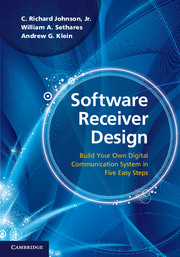Book contents
- Frontmatter
- To the Instructor …
- Contents
- Dedication
- Step 1 The Big Picture
- Step 2 The Basic Components
- Step 3 The Idealized System
- 4 Modeling Corruption
- 5 Analog (De)modulation
- 6 Sampling with Automatic Gain Control
- 7 Digital Filtering and the DFT
- 8 Bits to Symbols to Signals
- 9 Stuff Happens
- Step 4 The Adaptive Components
- Step 5 Putting It All Together
- Appendices
- Index
9 - Stuff Happens
from Step 3 - The Idealized System
Published online by Cambridge University Press: 05 June 2012
- Frontmatter
- To the Instructor …
- Contents
- Dedication
- Step 1 The Big Picture
- Step 2 The Basic Components
- Step 3 The Idealized System
- 4 Modeling Corruption
- 5 Analog (De)modulation
- 6 Sampling with Automatic Gain Control
- 7 Digital Filtering and the DFT
- 8 Bits to Symbols to Signals
- 9 Stuff Happens
- Step 4 The Adaptive Components
- Step 5 Putting It All Together
- Appendices
- Index
Summary
There is nothing new in this chapter. Really. By peeling away the outer, most accessible layers of the communication system, the previous chapters have provided all of the pieces needed to build an idealized digital communication system, and this chapter just shows how to combine the pieces into a functioning system. Then we get to play with the system a bit, asking a series of “what if” questions.
In outline, the idealized system consists of two parts, rather than three, since the channel is assumed to be noiseless and disturbance-free.
The Transmitter
codes a message (in the form of a character string) into a sequence of symbols,
transforms the symbol sequence into an analog signal using a pulse shape, and
modulates the scaled pulses up to the passband.
The Digital Receiver
samples the received signal,
demodulates to baseband,
filters the signal to remove unwanted portions of the spectrum,
correlates with the pulse shape to help emphasize the “peaks” of the pulse train,
downsamples to the symbol rate, and
decodes the symbols back into the character string.
Each of these procedures is familiar from earlier chapters, and you may have already written Matlab code to perform them. It is time to combine the elements into a full simulation of a transmitter and receiver pair that can function successfully in an ideal setting.
- Type
- Chapter
- Information
- Software Receiver DesignBuild your Own Digital Communication System in Five Easy Steps, pp. 165 - 190Publisher: Cambridge University PressPrint publication year: 2011



